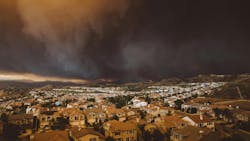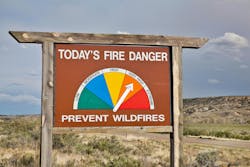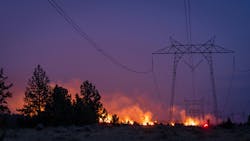Wildfire Safety Starts with Hardening Electrical Systems
Wildfires burn millions of acres across the U.S. every year. Even the smallest spark can ignite a wildfire. Although utility equipment is not the leading cause of wildfires, it is a critical factor to consider and a risk that can be greatly reduced through proactive strategies.
To effectively address climate-driven threats such as droughts and other conditions that contribute to wildfires, energy providers are developing mitigation plans to improve grid resiliency and protect their customers through every season. Wildfire mitigation planning requires a holistic assessment of the community’s specific challenges and vulnerabilities, including current infrastructure, climate risk and population density. More broadly, it is important to consider factors that could impact long-term storm hardening programs such as climate change, staffing and supply shortages, and North America’s aging infrastructure.
Through partner collaboration, utilities are shaping community-centered strategies that address today’s challenges and consider the unpredictability of tomorrow. Anticipating population shifts and integrating scalable solutions aligned with the community’s needs help to support grid resiliency and sustainability objectives, improve power quality and better protect against damaging wildfires.
Risks Span The Country
High-risk areas like California have regulations aimed at improving wildfire prevention, mitigation and response efforts. However, wildfires pose a threat in many areas of the country, including parts of the Midwest and Southwest. Rising temperatures and droughts, coupled with regional population growth, impact energy management planning.
Recent data shows the fastest-growing regions are the South and Southwest — areas with warm annual temperatures and higher wildfire risk. The U.S. Census Bureau estimates in 2023 the nation gained 1.6 million people and more states witnessed population growth than any year since the start of the pandemic.
As more Americans move to hotter climates, utilities must consider how they will support the increasing electrical needs of residents and businesses. Add to this, rising electrical consumption from powering more systems and services, including vehicles, transportation and communications, smart home devices, heating and cooling equipment, data centers and more.
Shifting electrical demand further strains the country’s aging infrastructure, with 70% of power transformers being 25 years of age or older, according to a notice of intent in January 2022 from the U.S. Department of Energy about its Building a Better Grid initiative.
With more frequent and sustained extreme weather events and heightened demand for electricity, utilities are confronted with the responsibility of protecting their communities while providing safe and reliable power. Compounded by industry-wide material and staffing shortages, energy providers are still managing project backlogs and working to fill gaps left by retiring workers. To streamline efficiencies and prepare newer workers with critical skills, products need to be fast and easy to install and require minimal training and maintenance.
Manufacturers are focused on developing solutions that decrease wildfire risk, are configurable and scalable to roll out, and require little to no ongoing maintenance. These electrical solutions help to make utility workers’ jobs safer and easier, are essential to an effective fire mitigation plan, and position providers to meet the growing demands on the grid.
Safer Solutions
Planning for grid resiliency looks different for every utility. Industry and manufacturer partners can provide expertise and guidance to update existing systems and transition to more sustainable solutions that address environmental concerns and increasing operations and maintenance (O&M) costs.
In many high-risk areas, strong winds pose a significant threat. One major factor in fire mitigation planning is reducing potential sparks from fuse operation that could be carried by winds to dry vegetation and ignite. By containing sparks that could be emitted during fuse operation, current-limiting fuse technology can significantly reduce fire risks through a hermetically sealed construction and current-limiting action.
One example is the Hi-Tech Trans-Guard EXT current-limiting backup fuse from ABB, which is included in the California Power Line Fire Prevention Field Guide that outlines procedures to minimize the risk of catastrophic wildfires caused by electrical power lines and equipment. Hi-Tech fuses have a proven 40-year history of reliable performance in the field. Current-limiting fuses for fire mitigation continue to be reimagined, like the Hi-Tech Valiant fuse. An advanced design, Hi-Tech Valiant fuses reduce energy let-through during a fault and offer a high interrupting capability for protection against ever-increasing available fault current.
Undergrounding is another approach electric utilities are implementing as part of fire mitigation and infrastructure planning. One of the most effective ways to safeguard communities, Pacific Gas and Electric Co. notes in its 2022 wildfire mitigation plan that taking electrical systems underground helps to reduce ignition risk by nearly 99%. Buried electrical lines offer many advantages, including minimizing outages caused by line contact from trees, falling limbs, lightning, high winds, ice and heavy snow. However, expense and implementation time are key considerations.
Developments in technology, equipment, materials and installation methods are enabling utilities to more easily underground lines and automate systems for minimal maintenance and faster recovery. Today’s more compact designs can be installed through narrow passages and manholes. Utilities can work with engineers and R&D specialists to integrate standard products and configure solutions to drop into an existing footprint or foundation.
No one should have to guess if it is safe to do their job. Advances in product designs prioritize worker safety and expand field-proven options for storm-hardening programs. Innovative undergrounding solutions include three-phase and single-phase switchgear with a viewing window that enables workers to visually verify the circuit is deenergized before performing maintenance.
Grid Resiliency Planning
Wildfires have become a year-round concern for many communities across the country, and utilities are integrating safer solutions and proactive strategies to stay ahead of the threat.
Digitalization and automation have become critical to infrastructure modernization strategies. Improving digital communications within electrical systems allows for faster alerts of system faults and better prediction of equipment maintenance or potential equipment failure. Damaged equipment can fail to operate, as well as generate heat and become a source of ignition. Digital insights support field crews by continual monitoring and assessment of equipment needing maintenance, repair and replacement.
Wildfires are a constant and evolving threat utilities must address at multiple levels. Through collaboration with manufacturing partners, utilities are developing forward-looking, community-centered strategies that incorporate high-performing solutions to save time and labor as well as improve safety — for residents, crews and the environment.
Aaron Motes ([email protected]) is a research and development engineer for ABB Installation Products, formerly Thomas & Betts, in Ormond Beach, Florida. Motes focuses on product design, development and testing. He works with utilities across the country and develops new technology for Hi-Tech current limiting fuses and Homac custom solutions, utility connectors and custom configurations to extend the Color-Keyed compression system line of ready-made products. - ABB Installations
About the Author
Aaron Motes
Aaron Motes is a research and development engineer for ABB Installation Products, formerly Thomas & Betts, in Ormond Beach, Florida. Motes focuses on product design, development and testing. He works with utilities across the country and develops new technology for Hi-Tech current limiting fuses and Homac custom solutions, utility connectors and custom configurations to extend the Color-Keyed compression system line of ready-made products.


